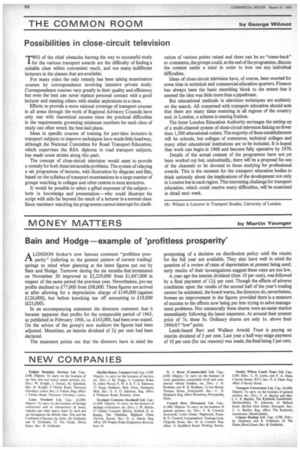Possibilities in close-circuit television
Page 70

If you've noticed an error in this article please click here to report it so we can fix it.
0 of the chief obstacles barring the way to successful study for the various transport awards are the difficulty of finding a suitable class within convenient reach, and too many indifferent lecturers in the classes that are available.
For many years the only remedy has been taking examination courses by correspondence involving intensive private study. Correspondence courses vary greatly in their quality and efficiency but even the best can never replace personal contact with a good lecturer and meeting others with similar aspirations in a class.
• Efforts to provide a more rational coverage of transport courses in all areas through the work of Regional Advisory Councils have only met with theoretical success since the practical difficulties in the requirements governing minimum numbers for each class of study can often wreck the best-laid plans.
Ideas in specific courses of training for part-time lecturers in transport subjects to improve techniques have made little headway, although the National Committee for Road Transport Education, which supervises the RSA diploma in road transport subjects, has made some strides along this path.
The concept of close-circuit television would seem to provide a remedy for both these intractable problems. The system of relaying a set programme of lectures, with illustration by diagram and film, based on the syllabus of transport examinations to a large number of groups watching in colleges and other centres is most attractive.
It would be possible to select a gifted exponent of the subject— both in knowledge and presentation—who could illustrate his script with aids far beyond the reach of a lecturer in a normal class. Since members watching the programme cannot interrupt for clarifi
cation of various points raised and there can be no "come-back" or comments, the groups could, at the end of the programme, discuss the content under a tutor in order to iron out any individual difficulties.
Ideas of close-circuit television have, of course, been mooted for some time in technical and commercial education quarters. Finance has always been the basic stumbling block to the extent that it seemed the idea was little more than a pipedream.
But educational methods in television techniques are suddenly on the march. All concerned with transport education should note that there are many ideas maturing in all regions of the country and, in London, a scheme is nearing fruition.
The Inner London Education Authority envisages the setting-up of a multi-channel system of close-circuit television linking no fewer than 1,300 educational outlets. The majority of these establishments will be schools, but colleges of commerce, technical colleges and many other educational institutions are to be included. It is hoped that work can begin_in 1968 and become fully operative by 1970.
Details of the actual content of the programme have not yet been worked out but, undoubtedly, there will be a proposal for one of the channels to be devoted to those studying for professional awards. This is the moment for the transport education bodies to think seriously about the implications of the development not only in London but in each region. This interesting challenge for transport education, which could resolve many difficulties, will be examined in detail next week.
Mr. Wilmot is Lecturer in Transport Studies, University of London.
















































































































